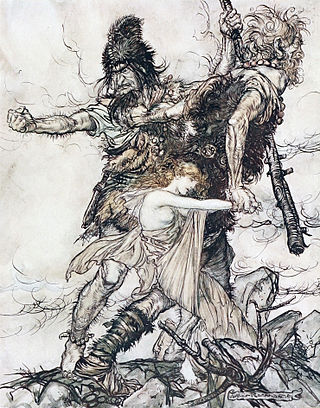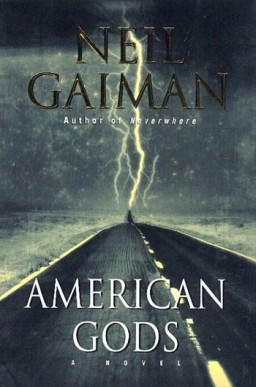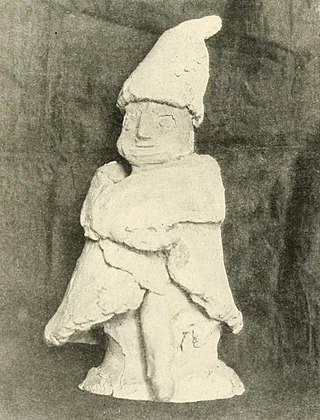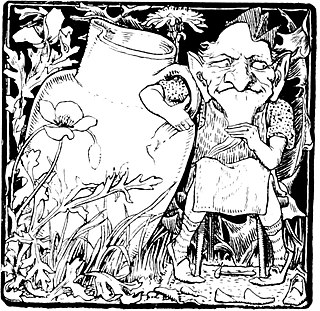
In English folklore, Puck, also known as Robin Goodfellow, is a domestic and nature sprite, demon, or fairy.

In folklore, giants are beings of humanoid appearance, but are at times prodigious in size and strength or bear an otherwise notable appearance. The word giant is first attested in 1297 from Robert of Gloucester's chronicle. It is derived from the Gigantes of Greek mythology.
A boggart is a creature in English folklore, either a household spirit or a malevolent genius loci inhabiting fields, marshes, or other topographical features. Other names of this group include bug, bugbear, bugaboo or bug-a-boo, bogey, bogun, bogeyman, bogle, etc., presumably all derived from Old English pūcel, and related to the Irish púca and the pwca or bwga of Welsh mythology.

American Gods (2001) is a fantasy novel by British author Neil Gaiman. The novel is a blend of Americana, fantasy, and various strands of ancient and modern mythology, all centering on the mysterious and taciturn Shadow.

A kobold is a mythical sprite. Having spread into Europe with various spellings including "goblin" and "hobgoblin", and later taking root and stemming from Germanic mythology, the concept survived into modern times in German folklore.

In mythology, folklore and speculative fiction, shape-shifting is the ability to physically transform oneself through unnatural means. The idea of shape-shifting is in the oldest forms of totemism and shamanism, as well as the oldest existent literature and epic poems such as the Epic of Gilgamesh and the Iliad. The concept remains a common literary device in modern fantasy, children's literature and popular culture.
A hobgoblin is a household spirit, appearing in English folklore, once considered helpful, but which since the spread of Christianity has often been considered mischievous. Shakespeare identifies the character of Puck in his A Midsummer Night's Dream as a hobgoblin.

A pixie is a mythical creature of British folklore. Pixies are speculated to be particularly concentrated in the high moorland areas around Devon and Cornwall, suggesting some Celtic origin for the belief and name.

English folklore consists of the myths and legends of England, including the English region's mythical creatures, traditional recipes, urban legends, proverbs, superstitions, and folktales. Its cultural history is rooted in Celtic, Christian, Nordic and Germanic folklore.

A household deity is a deity or spirit that protects the home, looking after the entire household or certain key members. It has been a common belief in paganism as well as in folklore across many parts of the world.

Swiss folklore describes a collection of local stories, celebrations, and customs of the alpine and sub-alpine peoples that occupy Switzerland. The country of Switzerland is made up of several distinct cultures including German, French, Italian, as well as the Romansh speaking population of Graubünden. Each group has its own unique folkloric tradition.

German folklore is the folk tradition which has developed in Germany over a number of centuries. Seeing as Germany was divided into numerous polities for most of its history, this term might both refer to the folklore of Germany proper and of all German-speaking countries, this wider definition including folklore of Austria and Liechtenstein as well as the German-speaking parts of Switzerland, Luxembourg, Belgium, and Italy.

The clurichaun or clúrachán is a mischievous fairy in Irish folklore known for his great love of drinking and a tendency to haunt breweries, pubs and wine cellars. He is related to the leprechaun and has sometimes been conflated with him as a shoemaker and a guardian of hidden treasure. This has led some folklorists to suppose that the clurichaun is merely a leprechaun on a drinking spree, while others regard them as regional variations of the same being. Like the leprechaun, the clurichaun is a solitary fairy, encountered alone rather than in groups, as distinct from the trooping fairies.

A lutin is a type of hobgoblin in French folklore and fairy tales. Female lutins are called lutines.
The mythology of the modern-day Netherlands, Belgium and Luxembourg has its roots in the mythologies of pre-Christian cultures, predating the region's Christianization under the influence of the Franks in the Early Middle Ages. At the time of the Roman Empire and in the Early Middle Ages, some of the resident peoples of the Low Countries' included:
Mythic humanoids are legendary, folkloric, or mythological creatures that are part human, or that resemble humans through appearance or character. Each culture has different mythical creatures that come from many different origins, and many of these creatures are humanoids. They are often able to talk and in many stories they guide the hero on their journey.

A hob is a type of small mythological household spirit found in the English Midlands, Northern England, and on the Anglo-Scottish border, according to traditional folklore of those regions. They could live inside the house or outdoors. They are said to work in farmyards and thus could be helpful; however, if offended they could become nuisances. The usual way to dispose of a hob was to give them a set of new clothing, the receiving of which would make the creature leave forever. It could, however, be impossible to get rid of the worst hobs.

King Goldemar is a dwarf or kobold from Germanic mythology and folklore. By the Middle Ages, Goldemar had become the king of the dwarfs in German belief. In the fairy tale "The Friendship of the Dwarfs", the author Villamaria depicts Goldemar as a "mighty dwarf king" with a queen and a court of dwarf nobles at his service. He has long, silver hair and beard and wears a crown and a purple mantle. In one tale, he runs away with the daughter of a human king. Fragments of an epic poem by Albrecht von Kemenaten called Goldemar survive. The poem tells of Dietrich's encounter with the dwarf king. The king also features in "Der junge König und die Schäferin" by German poet Ludwig Uhland. Goldemar's brothers, Alberich or Elberich and Elbegast, feature in other poems.
A Bieresel is a type of kobold of German folklore.













